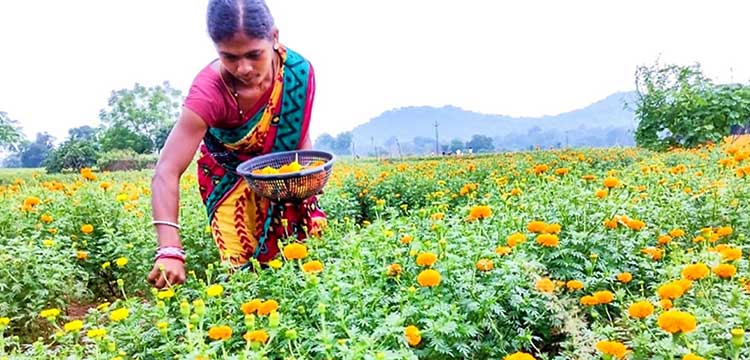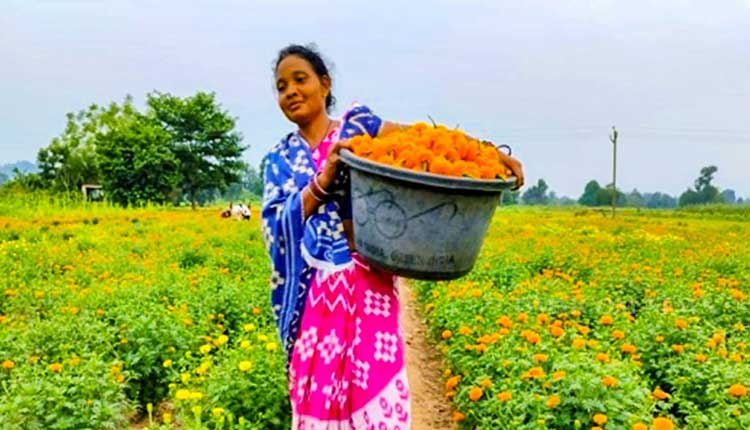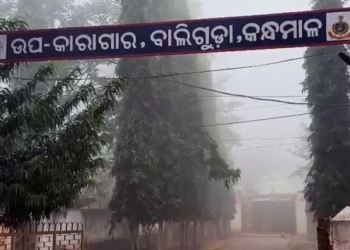Bhubaneswar: Marigold has long held a special place in the hearts of the people of Odisha. It is cherished for its aesthetic appeal and has been an integral part of religious occasions, functions, and festivals, gracing them as a symbol of decoration and purity. Traditionally, the marigolds came from neighbouring West Bengal to meet the high demand in Odisha. However, the Agriculture Production Cluster (APC) project in Rayagada has changed the landscape of marigold cultivation.
In 2019-20, the district administration, in collaboration with the Odisha Livelihood Mission (OLM), Mission Shakti, Directorate of Horticulture, and the APC partner PRADAN, initiated the cultivation of marigold in Rayagada. This venture aimed to provide an alternative livelihood for the APC farmers in the region.
To kickstart the project, the Odisha Livelihood Mission distributed seedlings and essential inputs as grants to women farmers in Kolnara and Bissamcuttack blocks. The farmers received technical knowledge and support from the Directorate of Horticulture and PRADAN. With this support, 30 farmers across three villages cultivated marigold on nine acres of land, with remarkable success.

The first year witnessed the farmers reaping the benefits of marigold cultivation, with each acre generating an income of Rs 60,000 to Rs 70,000. This success story inspired other farmers in Kolnara block to adopt this short-duration, high-value crop. As a result, marigold cultivation saw an upsurge in the region.
In the second year, a farmers’ producer company named Pragati Farmer’s Producer Company was established in Kolnara block. This company received financial support from Mission Shakti and provided doorstep market support to women farmers through the Odisha Rural Development and Marketing Society (ORMAS). By 2023-24, around 451 farmers had taken up marigold cultivation, covering over 120 acres.

OLM has continued to support the farmers for the last four years by providing saplings. The self-help group (SHG) members are also credit-linked to Mission Shakti Block Level Federation (BLF) for marigold cultivation, further enhancing the scope of this endeavour.
Marigold is an ideal crop for Rayagada, as it thrives in rain-fed conditions with a temperature range of 17-35 degrees Celsius. The total input cost for marigold cultivation per acre is Rs 20,000, with OLM contributing Rs 7,000. Farmers typically yield between 2,000 to 2,500 kilograms per acre, selling at an average rate of Rs 35 per kilogram. This results in a gross income of Rs 70,000 to Rs 87,000 per acre, with a net income ranging from Rs 50,000 to Rs 67,000.
| Particulars | Amount in Rs | Support from OLM | Farmer contribution |
| Seedling cost | 7000 | 7000 | |
| Fertilizer | 3000 | 0 | 3000 |
| Plant growth hormones & medicines | 9000 | 0 | 9000 |
| Fungicide | 1000 | 0 | 1000 |
| Total input cost per acre | 20000 | 7000 | 13000 |
In Rayagada, farmers mainly target festivals like Dussehra and Diwali, followed by Kartika month and Maha Laxmi Puja. To accommodate this, OLM provides saplings to farmers in three batches. In the past fiscal year, 379 farmers from Kolnara block collectively marketed 98.06 metric tons of marigold in different markets of Odisha and Andhra Pradesh.
The Mission Shakti-sponsored FPC (Mahila Pragati Farmers Producer Company Limited) successfully marketed 45.55 metric tons of marigold with a turnover of Rs 17.56 lakh in the 2022-23 fiscal year.
Despite these achievements, there are challenges to overcome, such as fluctuating market prices during the festive season. To address this, value addition options like processing marigold for lutein, a valuable nutrient, and capacity building for farmers in garland preparation and cold storage could help them scale up their efforts.
In Rayagada, marigold is no longer just a symbol of tradition and beauty; it’s also a beacon of hope, financial prosperity, and community development. As the marigold industry continues to flourish, it is clear that this project is not only transforming livelihoods but also blooming into an enduring success story for the region.
















